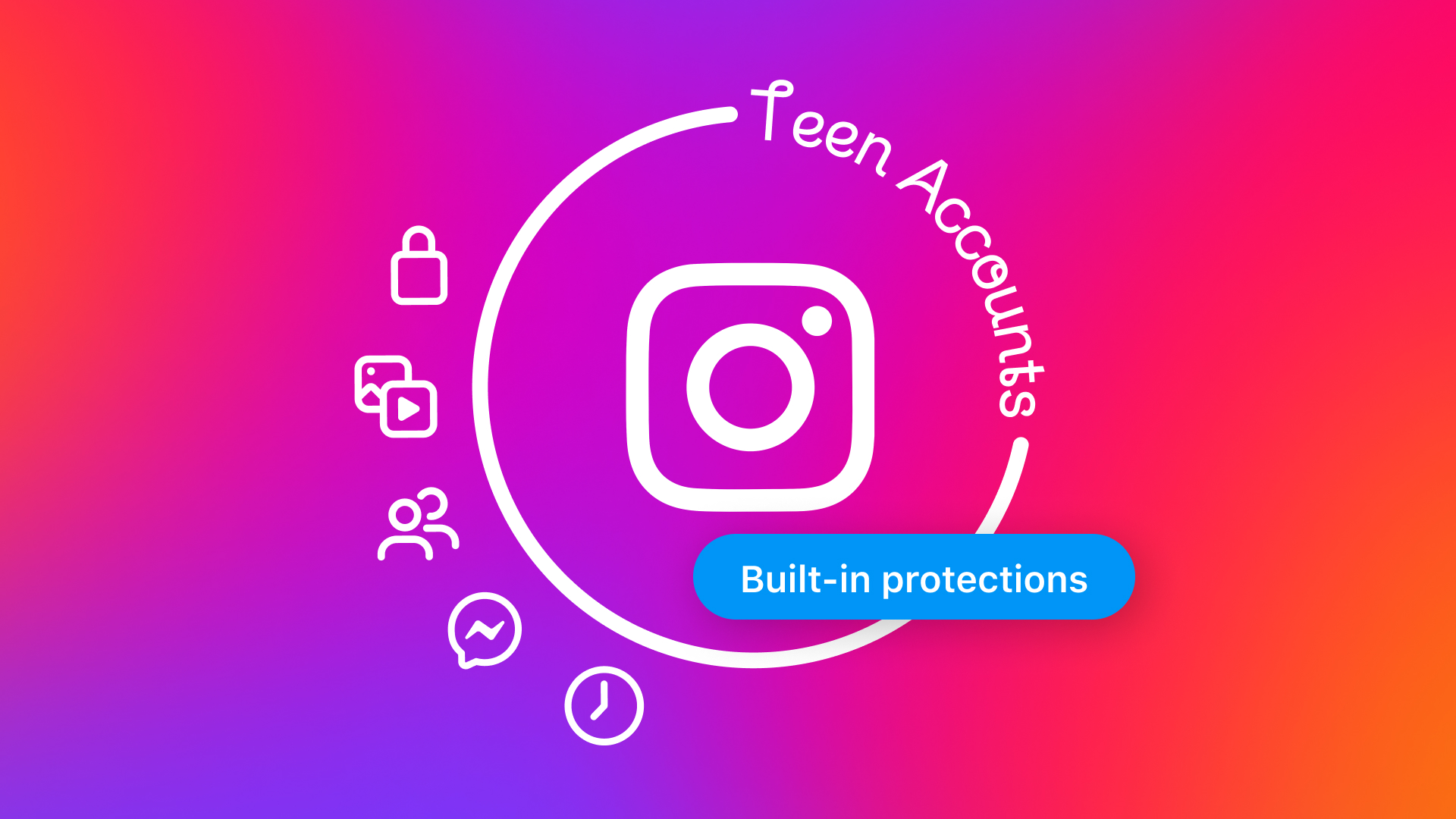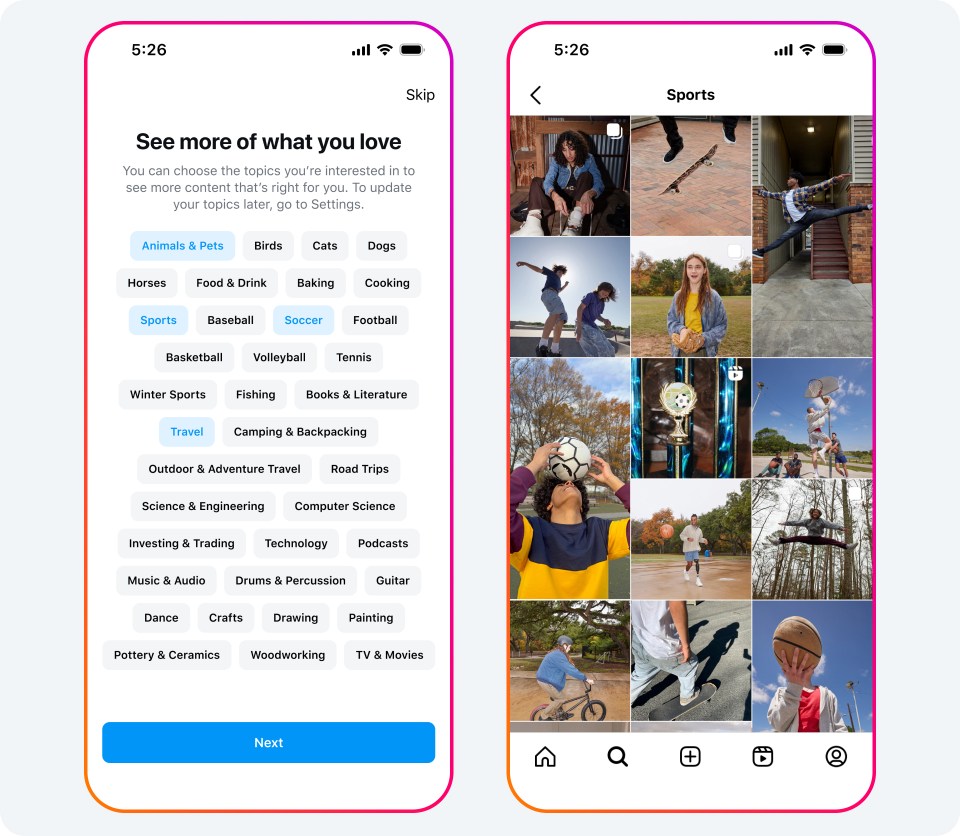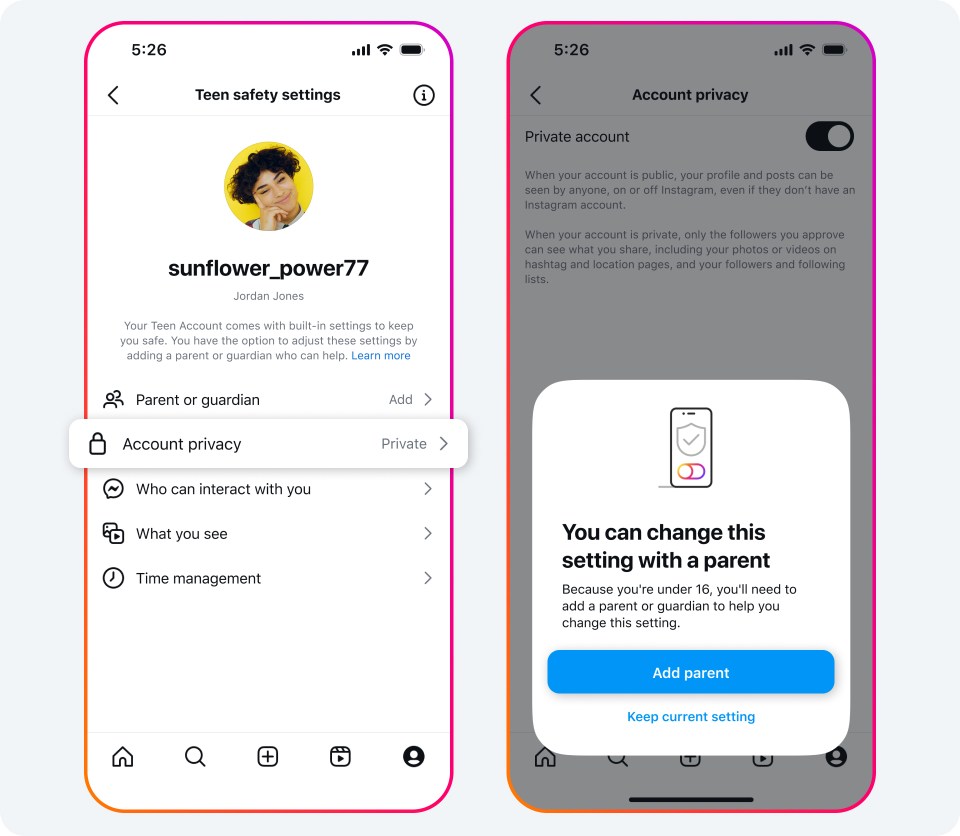Today, we’re introducing Instagram Teen Accounts, a new experience for teens, guided by parents. Teen Accounts have built-in protections which limit who can contact them and the content they see, and also provide new ways for teens to explore their interests. We’ll automatically place teens into Teen Accounts, and teens under 16 will need a parent’s permission to change any of these settings to be less strict.
Reimagining Teens’ Experiences on Instagram
We know parents want to feel confident that their teens can use social media to connect with their friends and explore their interests, without having to worry about unsafe or inappropriate experiences. We understand parents’ concerns, and that’s why we’re reimagining our apps for teens with new Teen Accounts. This new experience is designed to better support parents, and give them peace of mind that their teens are safe with the right protections in place. Teens will also get access to a new feature, made just for them, that lets them select topics they want to see more of in Explore and their recommendations so they can focus on the fun, positive content they love.
Built-In Protections To Address Parents’ Top Concerns
We developed Teen Accounts with parents and teens in mind. The new Teen Account protections are designed to address parents’ biggest concerns, including who their teens are talking to online, the content they’re seeing and whether their time is being well spent. These protections are turned on automatically, and parents decide if teens under 16 can change any of these settings to be less strict:
- Private accounts: With default private accounts, teens need to accept new followers and people who don’t follow them can’t see their content or interact with them. This applies to all teens under 16 (including those already on Instagram and those signing up) and teens under 18 when they sign up for the app. (Updated on September 17 at 11:18 AM PT to clarify how private accounts are applied)
- Messaging restrictions: Teens will be placed in the strictest messaging settings, so they can only be messaged by people they follow or are already connected to.
- Sensitive content restrictions: Teens will automatically be placed into the most restrictive setting of our sensitive content control, which limits the type of sensitive content (such as content that shows people fighting or promotes cosmetic procedures) teens see in places like Explore and Reels.
- Limited interactions: Teens can only be tagged or mentioned by people they follow. We’ll also automatically turn on the most restrictive version of our anti-bullying feature, Hidden Words, so that offensive words and phrases will be filtered out of teens’ comments and DM requests.
- Time limit reminders: Teens will get notifications telling them to leave the app after 60 minutes each day.
- Sleep mode enabled: Sleep mode will be turned on between 10 PM and 7 AM, which will mute notifications overnight and send auto-replies to DMs.
“Given that parents today are grappling with the benefits and challenges of the internet and digital media for their teens, our association applauds Meta for launching Instagram Teen Accounts. With teens automatically placed in Teen Accounts and certain privacy settings turned on by default, this update demonstrates that Meta is taking steps to empower parents and deliver safer, more age-appropriate experiences on the platform.”
– Yvonne Johnson, President, National PTA
How To Approve Changes To a Teen’s Settings
Teens under 16 will need their parent’s permission to use less protective settings. To get permission, teens will need to set up parental supervision on Instagram. If parents want more oversight over their older teen’s (16+) experiences, they simply have to turn on parental supervision. Then, they can approve any changes to these settings, irrespective of their teen’s age.
Once supervision is established, parents can approve and deny their teens’ requests to change settings or allow teens to manage their settings themselves. Soon, parents will also be able to change these settings directly to be more protective. Learn more about how to manage Teen Accounts.
“Instagram Teen Accounts reflect the importance of tailoring teens’ online experiences to their developmental stages, and implementing appropriate protections. Younger adolescents are more vulnerable as their skills are still emerging and require additional safeguards and protection. Overall, the settings are age-specific, with younger and older teens being offered different protections.”
– Rachel Rodgers, PhD Associate Professor of Applied Psychology, Northeastern University
More Ways for Parents To Get Involved, If They Want
While Teen Accounts put new protections in place automatically, many parents want to be even more involved in their teen’s experiences, so we’re also adding to our supervision feature. Updates include ways to:
- Get insights into who their teens are chatting with: While parents can’t read their teen’s messages, now they will be able to see who their teen has messaged in the past seven days.
- Set total daily time limits for teens’ Instagram usage: Parents can decide how much time their teen can spend on Instagram each day. Once a teen hits that limit, they’ll no longer be able to access the app.
- Block teens from using Instagram for specific time periods: Parents can choose to block their teens from using Instagram at night, or specific time periods, with one easy button.
- See topics your teen is looking at: Parents can view the age-appropriate topics their teen has chosen to see content from, based on their interests.
How We’re Enforcing Teen Accounts
Teens may lie about their age and that’s why we’re requiring them to verify their age in more places, like if they attempt to use a new account with an adult birthday. We’re also building technology to proactively find accounts belonging to teens, even if the account lists an adult birthday. This technology will allow us to proactively find these teens and place them in the same protections offered by Teen Account settings. We’ll start testing this change in the US early next year. You can read more about those details here.
Helping Ensure Teens See Age-Appropriate Content
We recognize parents are concerned that their teens might see mature or inappropriate content online, which is why we have stricter rules around the kinds of content teens see on our apps. We remove content that breaks our rules and avoid recommending potentially sensitive content – such as sexually suggestive content or content discussing suicide or self-harm. With Instagram Teen Accounts, teens will be placed into the strictest setting of our sensitive content control, so they’re even less likely to be recommended sensitive content, and in many cases we hide this content altogether from teens, even if it’s shared by someone they follow.
“It’s important that safety and privacy protections are the default settings, both to improve teens’ online experience and to reduce some of the burden that has fallen to parents. We look forward to hearing from teens about their experience of these new Teen Accounts and associated features and settings.”
– Dr. Megan Moreno, Co-Medical Director of the SAMHSA-Funded AAP Center of Excellence on Social Media and Youth Mental Health
When To Expect These Changes
Today, we’ll start placing teens who sign up for Instagram into Teen Accounts, and we’ll notify teens already using Instagram about these changes so we can begin moving them into Teen Accounts next week.
We plan to place teens into Teen Accounts within 60 days in the US, UK, Canada and Australia, and to start placing them in Teen Accounts in the European Union later this year. Teens around the world will start to get Teen Accounts in January. We’ll also bring Teen Accounts to other Meta platforms next year. These are big updates that will change the Instagram experience for millions of teens, and we need to make sure they work correctly.
“These updates to Instagram’s Teen Accounts offer a balanced approach, empowering parents with essential oversight while respecting teens’ right to participate and explore. In an ever-evolving online world, this update ensures that young people can engage meaningfully and safely, fostering positive connections while still providing the protection they need.”
– Lucy Thomas OAM, CEO & Co-Founder, Project Rockit



